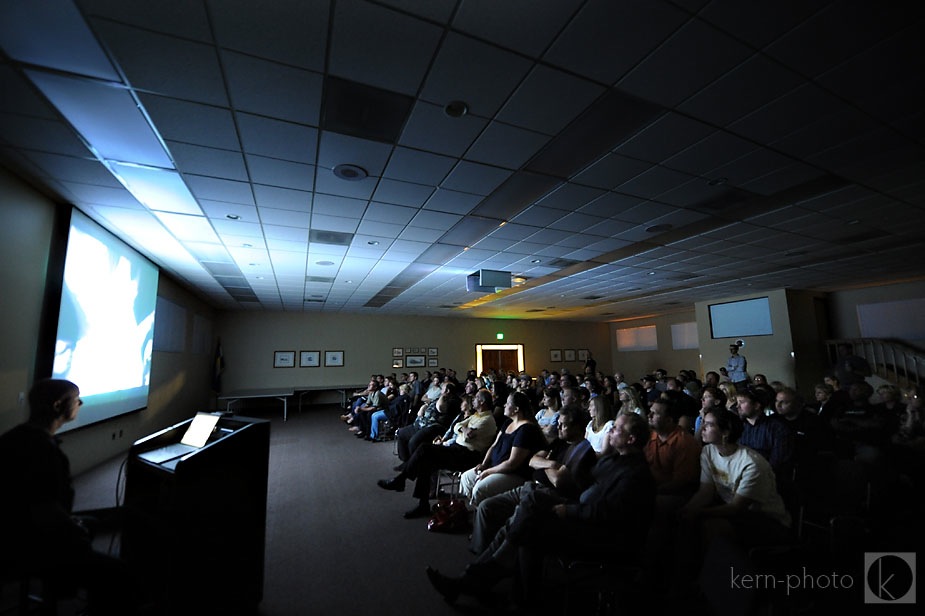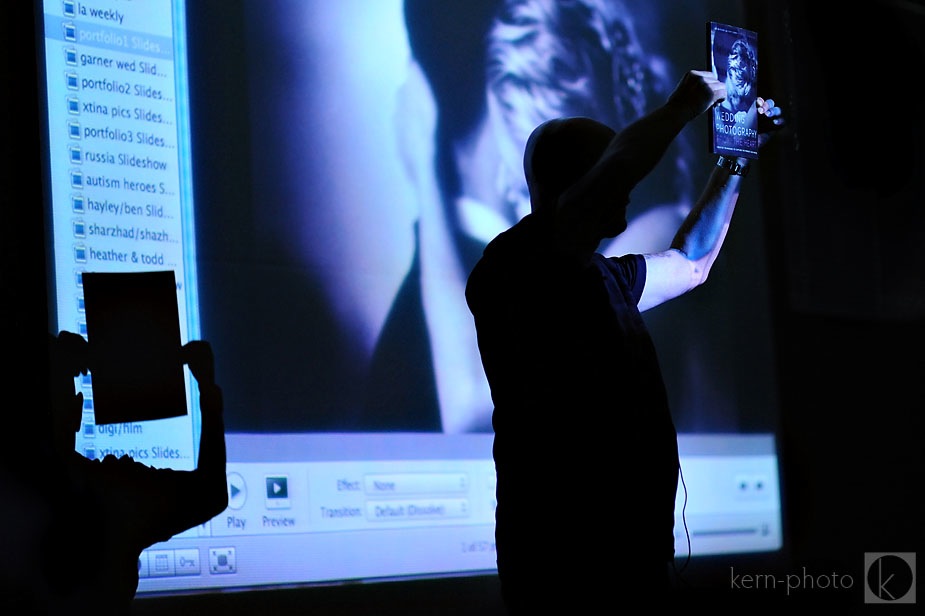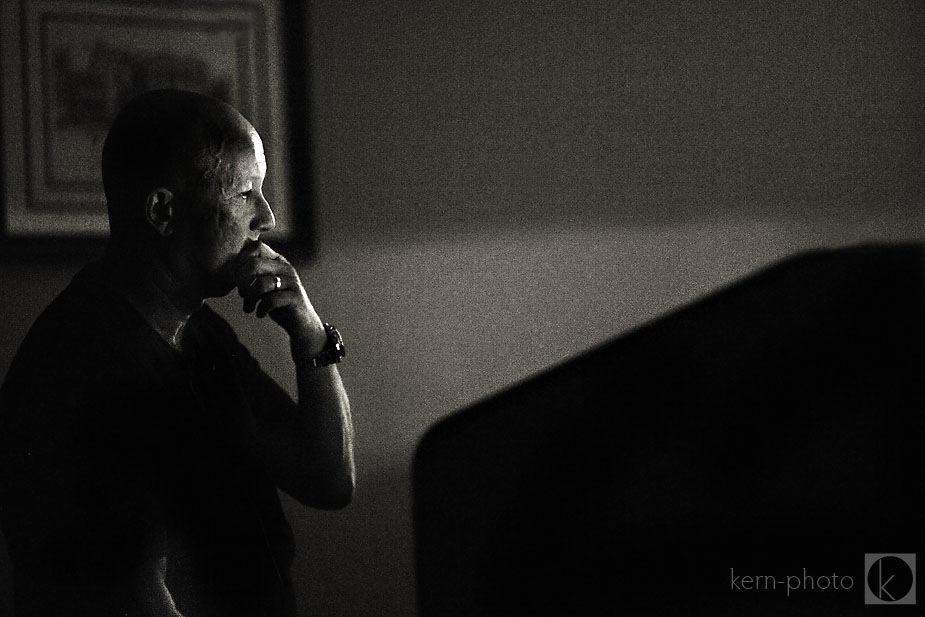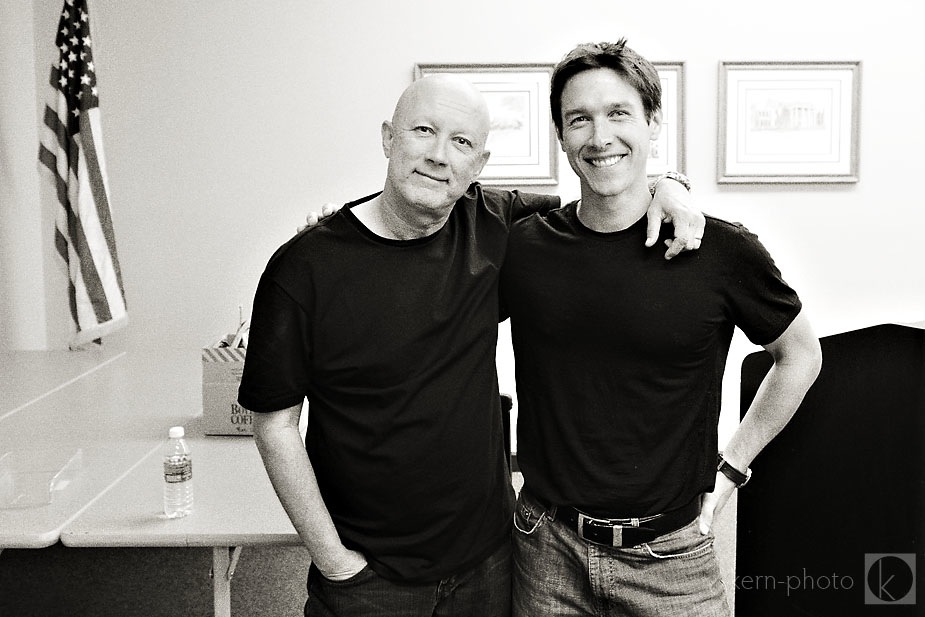joe buissink, behind the podium
Celebrity wedding photographer, Joe Buissink, spoke at the Denver PUG meeting last night. Events like these are among the reasons we use Pictage. Joe Buissink uses pictage for his clients, which include Jennifer Lopez, Jessica Simpson & Nick Lachey, among many others. Joe’s work is published regularly in publications like Grace Ormonde Wedding Style and InStyle Weddings. Joe is a legend in the wedding photographer world, to say the least.
During the presentation, I scribbled eight pages of notes and devoured heaps of golden-nugget information Joe shared with a packed room of 100+ Denver photographers. His talk reminded me of a favorite college class taught by a uber-cool professor, in which all I learned transcended classroom walls and applied directly to the “real-world,” the perfect balance between inspiring and informing. Here’s his stage:

Joe placed less emphasis in his presentation on “how-to” and more about the “why” of being a photographer. Kudos, kudos, Joe,… these are the type of presentation that really “stick” in my mind and don’t make me feel like I’m drinking water from a fire hose. Listed below are 10 things I took away from his session:
1. Know who you are. Looking inside is the only way to find “your style.” Joe emphasized the most important thing about photography is “who you are.” Stand out from the crowd and be different. Be you. Understanding “who we are” as a photographer has huge impact on how our images are read by others, especially clients. Every time you take a picture, you leave a piece of you in every picture. Shooting from the heart has many rewards, including happy clients and a happy self.
2. Follow your passion. This key ingredient is pivotal in avoiding burnout and making your efforts feel more like a typical 9-5 job. It shouldn’t be. Your work suffers as a result. Passion fuels our work. Joe calls himself a “full-time second shooter,” which helps to relieve much of the potential stress characteristic with weddings. Essential to this “marriage in heaven,” Joe hires, and pays well, a “primary” shooter to shoot formals, table shots, image requests by family, etc. often, guests at weddings do not even know he is the “big cheese.”
3. Play. Feelings of uncomfortableness and willingness of trying something different helps to fuel creative energy. “Being able to play” can something as simple as trying out a different type of film technique. Some of Joe’s recent “play” work employs capturing just blacks and just whites in an image, no grey tones.
4. Prompt & create moments. Ask the bride “How are you feeling in this moment” to elicit emotion. “Works every time,” Joe says. “Moment between moments” can reveal the essence of emotion, like the anticipation of a punchline of a joke. These moments become crystalized in time and in 20 years, such lucid memories will be remembered ‘like yesterday.’ Joe’s forthcoming book, “Wedding Photography from the Heart: Creative Techniques to Capture the Moments that Matter ” (due 10.27.09), should provide great insight on the topic. Below, Joe holds an advanced copy of the book while he talks about the cover image projected on the screen behind him.

5. Trust in your equipment. “M” on the camera means “master” and “P” means professional, not manual and program mode. Trust in the technology of your equipment, such as metering difficult light, yet know it’s limitations. Don’t be afraid to shoot in auto WB & program mode. Just know when that “sometimes” is.
6. Nurture relationships. Continue to nurture client relationship after the wedding. Special surprises, such as a signed 8×10 print or bottle of wine goes a long way. You can’t give buy good will, only give it. Chances are it will come back.
7. Sign your work. Joe never calls himself an artist, but he signs his work. Perceived value and pride go a long way. More of a “signature-style” comes from the actual person behind the lens than the resulting image. Clients hire a photographer as a person who is a coordinator, friend, honest companion, and not just someone who create images. Client emotion remains in the photograph. Being “yourself” goes a long way into leaving a slice of “you” in the image, an ingredient in a “signature-style.”
8. Train yourself. Moments happen quickly. you have to be ready to anticipate and capture them. This is a physical, learned behavior which can be practiced sans camera. See an emotion? Gesture with your hands or say “BAAMM!” (not outloud) to reinforce the physical process of seeing the moment and reacting. When you have a camera, you’ll be that much quicker at seizing the moment in-camera. To become an expert, do this every day wherever you are.
9. Feed your soul. And feed it with “other” stuff. Give back to the community. The power you can gain from it goes beyond words. Joe supports organizations such as the Make-a-Wish foundation and Now I Lay Me Down to Sleep. 100% of the proceeds from joe’s latest book, “Autism Heroes: Portraits of Families Meeting the Challenge,” benefits charity.
10. Show the work you love. When clients hire you, you are free to create the work that you like, which further energizes creativity.

Joe is an inspiration to me, and meeting him was one of my 101 photo goals in 1,001 days. I remember reading a Nikon advertisement a few years ago in which he spoke about his favorite lens, the legendary Nikon 85mm f/1.4. I researched the lens, tried it out, and was hooked. The lens has been a staple lens in our gear bag and has helped to create a look which has grown to become a signature kern-photo style. The above shot was taken with a Nikon d-700, at 85mm, ISO 3200, 1/60 second, f1.4 and “pushed” in photoshop the equivalent of three extra stops. Pushing the limits of light is something Joe does masterfully. To me, the above portrait encapsulates the seriousness in which he shared his vision, art, and heart that evening.
I look forward to spending more time with Joe Bussink at Partnercon 2009. Here we are (photo by Dusty Volkel):
Tech note: “Joe, why, oh, why did you switch from Canon to Nikon (the dark side)?” His answer (paraphrased): At the time, he was shooting the Nikon d2 and needed a system to allowed for cleaner images at higher ISOs, thus the switch. Joe still has all his own Nikon equipment, including his F3. And that 85mm f/1.4? It’s still a favorite lens in his bag.






11 Responses to “joe buissink, behind the podium”